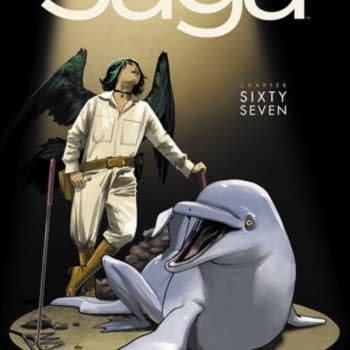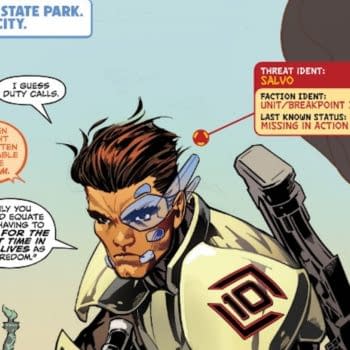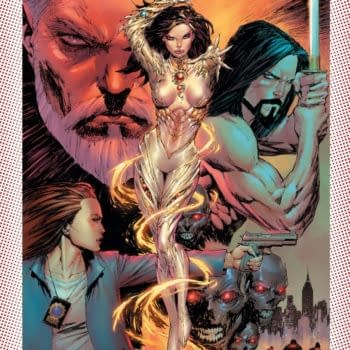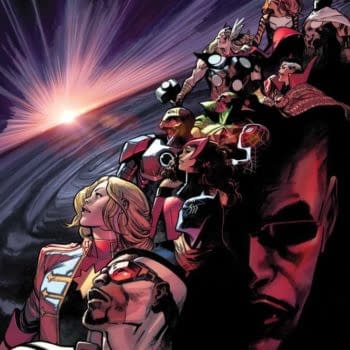Posted in: Comics, Recent Updates | Tagged: Comics, david liss, dynamite, the spider
The Spider #1 Commentary By David Liss
It's sold out. It's gone to second print. To talk us through it, David Liss writes for Bleeding Cool;
Page One
This is all about setting the mood. I wanted to create the sense that this is today's New York City, but also kind of not – a little darker, a little pulpier. The blimp in the background goes a long way toward making that happen (Colton and I both agreed that there should be blimps!). So I began with a montage, little snippets of crime and suffering to give the sense right from the get go that this city needs a hero. Then we end with the lost teenage girl which allowed me to segue into what is, I hope, a classic superhero into.
Page Two – Three

Colton decided to make these pages a spread, and it works really well because it gives you the whole range of what the Spider is about – we see the kinds of crime he is trying to stop and just how ruthless he is in stopping it. Check out how monstrous he looks in the panel on the far left. At the same time you see that, despite the Spider's cold and pitiless attitude toward the bad guys, he is motivated by compassion. Plus, I love the spidery borders.
Page Four
Here we're still establishing the Spider as a force to be reckoned with. He's quick and he's brutal. The captions are important for helping to clarify the character's motivation, and that was something that was very important to me. From the get-go, I wanted to do something more interesting than taking a classic pulp hero through his paces. The Spider is a character, and if he's a character who goes around shooting bad guys without remorse, then he's got to be at least kind of messed up. Why does he do these things? Because he can and because someone has to – at least in his view. The Spider is willing to take himself to the edge because if he doesn't, the world will be much worse off. Plus, this page has more cool borders from Colton!
Page Five
The Spider brands his emblem on the foreheads of his victims. It's a classic trademark of the character, and I wanted to get that in there quickly. Sewing fear is one of the best ways for the Spider to keep himself alive, and mutilating the corpses of your victims is certainly a time-honored method of sewing fear. It's pretty twisted when you think about it. However, right away we get the Spider's extreme behavior juxtaposed with his motivation. The bad guys he killed were human traffickers. Extreme punishments for extreme crimes – and really, that's at the heart of who the Spider is. He is over-the-top because his enemies are over-the-top. Also, I really love the red spider laser in the first panel.
Page Six
We've established that the Spider is a bad-ass vigilante, and now we need to establish the man behind the mask. One of the distinctive things about Richard Wentworth in the pulps was that he was affected deeply by the things he did and saw. The crimes and suffering he encountered took their toll on him. In the 1930s, Wentworth would work out his misery by playing his violin or his piano, and I guess that made him seem cool back then, but in my view it didn't translate to 2012. To me it made much more sense that he would blow off steam in less "cultured" ways, so I had Wentworth drink and smoke. He goes to a bar, but he remains anti-social. Even when surrounded by people who want to be around him, he remains alone. That's part of the price he pays for what he does.
Page Seven
Here we get about as much back-story as I ever dare put on a single page, but there are a lot of balls in the air. This page marks another big change I made from the source material – but in the interest in preserving the pulp's emotional power. The original Richard Wentworth could not marry his great love, Nita Van Sloan, because he believed it would be wrong to have her live with the constant risk of becoming a widow. This made sense in the patriarchal 1930s, but it would fall flat today. The love between Richard and Nita is a key element of the pulps, but so is the fact that can never truly be together. I thought it would be more complex and interesting if they couldn't be together because she is already married to someone else. Richard has made some bad, if understandable, decisions that led Nita to marry elsewhere. I knew this decision would make some purists unhappy, but I felt it was the best way to capture and update the power of the original story. Plus it sets the stage for great character subplots.
Page Eight
Like in the pulps, Nita knows Richard's secret. In the new configuration, this works well because it's a way for Richard to share an intimacy with her that doesn't cross any kind of line. Of course, it also binds them together and gives him a reason to stay in touch with her, so it's kind of sneaky. I wanted this page to make it clear that there is still a lot of sexual tension between these two.
Page Nine
What does a vigilante do after he pays a drunk visit to his old flame who is married to someone else? There's no better way to blow off steam than to go on a crime-fighting bender.
Page Ten
I threw in a little dark humor here. I'm playing for laughs, but I also wanted to show how routine gunning down criminals has become to the Spider. I also love how his mask looks in that last panel. One of the cool things Colton does is he makes the mask look like a mask – not a face. It makes the Spider extra creepy.
Page Eleven
Now that we've establish who the Spider is and what he does, and how the Spider persona related to the man behind the mark, it's time to kick the arc's plot into high gear. I think it's obvious I'm going for a classic noir feel. The brooding man, sitting in a dark apartment, drinking instead of sleeping,…. And rain makes everything moodier.
Page Twelve
In the pulps, the fact that Richard Wentworth had a ton of cash meant he had access to crime scenes. At least in fiction, wealth was like royalty, and a person with enough money and social standing could open all doors. Obviously, the rules have changed since then, and I needed a way to get Wentworth into the loop. Having him work as a police consultant seemed a good in. He's got a reason to visit crime scenes and his military experience gets him access to the more high-profile crimes.
I introduce a couple of big players on this page, one old and one new. In the pulps, Ram Singh was Wentworth's "Hindoo" manservant. Given that such a thing was an orientalist fantasy even in the 1930s, it would have been laughable to bring the character as-is into the current era. I chose to make Ram a lawyer because that way he would also have a reason for being at crime scenes. Besides Nita, he's the only person who knows for sure that Wentworth is the Spider.
One of the things that makes the Spider unusual when compared to modern superheroes is that everyone suspects his secret identity. It would have been easier to dump this aspect of the story, but I wanted to keep whatever was possible, so I decided to work with it. The cops suspect Wentworth but can't prove it. I created Joe Hilt as a foil, the cop who is in charge of catching the Spider. Guys like this are a hell of a lot of fun to write, and hopefully to read about.
Page Thirteen
More character development. Hilt is a jerk, Wentworth and Ram are cool.
Page Fourteen
Police Commissioner Kirkpatrick was a major Spider ally in the pulps, so of course we had to include him in our updated version. The twist: he's married to Nita Van Sloan! Have I mentioned I love character conflict? Also, note that both Hilt and Kirk are wearing hats. This is another nice touch from Colton. We keep things contemporary, but it gives the story a nice neo-pulp vibe.
Page Fifteen
We get our first good look at the time scene. Lots of gruesome dead bodies, and we establish that there is something extraordinary about the time, making it perfect for the Spider's attention.
Page Sixteen
Since Kirk is conflicted about the Spider, I wanted to offer a montage to give the reader a sense of what kinds of villains he has been fighting. In the pulps, the Spider was one of the first heroes to encounter larger-than-life villains with costumes or loony names, and here we see him fighting three enemies from the pulps – The Cholera King, the Silver Falcon, and The Legion & his Terrors. Colton's rendering of the Cholera King is especially cool. It makes me sorry the guy is already dead.
Page Seventeen
They're not just a bunch of dead people killed by experimental military gas. They're zombies. Or at least zombie-esque. Again, I wanted to make sure that I stuck to the tradition of the Spider not just fighting villainy, but fighting insane villainy. I think a gas that turns people into zombies counts.
Pages Eighteen – Nineteen
A little cool horror action to raise the stakes. Plus we see that when the police panic, Wentworth keeps his cool and gets the job done. This, of course, only makes him more of a suspect for being the Spider.
Page Twenty – Twenty-One
Now we know who is behind the zombie gas attack, someone calling herself Anput, which the well-read Wentworth knows is the name of a minor Egyptian goddess. I gave a lot of thought to bringing back one of the villains from the pulps, but I decided that, for our first issue, it would be better to have an original enemy who captured the spirit of the pulps. Egyptian stuff always makes for cool visuals, as you will see in subsequent issues.
Page Twenty-Two
Here's my take on cliff-hangers. Too many comics end with a "How will they survive?" last page. Hero X is at the mercy of villain Y. This looks like the end. But, of course, it's really not because hero X is going to get out of it. I much prefer a "What the hell will happen next?" ending, and I wanted to make sure I delivered one for the first issue. Having the head blown off the head of a zombified child felt like it fit the bill. My goal here was to raise the stakes, shock the reader, and peak interest for the next issue. Colton does great work here, giving the moment the kind of horrific drama I was looking for. Hopefully everything worked, and we'll see you next time.





















